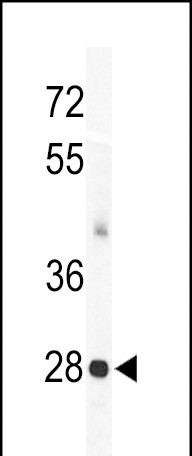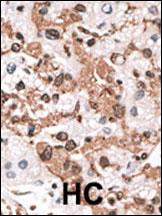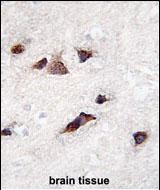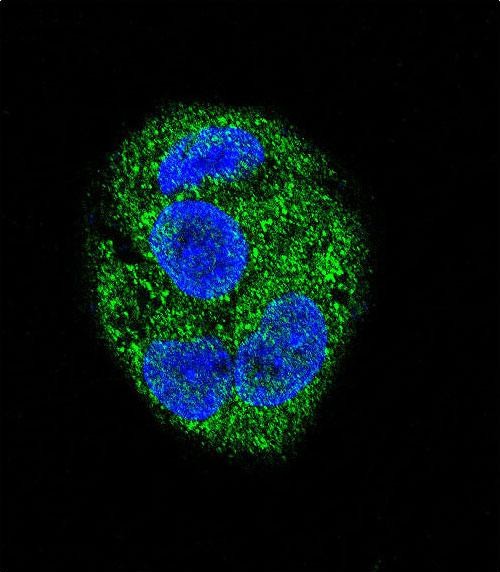KChIP3 Antibody (N-term M1)
Purified Rabbit Polyclonal Antibody (Pab)
- 产品详情
- 实验流程
- 背景知识
Application
| WB, IHC-P, IF, E |
|---|---|
| Primary Accession | Q9Y2W7 |
| Reactivity | Human, Mouse |
| Host | Rabbit |
| Clonality | Polyclonal |
| Isotype | Rabbit IgG |
| Calculated MW | 29231 Da |
| Antigen Region | 1-30 aa |
| Gene ID | 30818 |
|---|---|
| Other Names | Calsenilin, A-type potassium channel modulatory protein 3, DRE-antagonist modulator, DREAM, Kv channel-interacting protein 3, KChIP3, KCNIP3, CSEN, DREAM, KCHIP3 |
| Target/Specificity | This KChIP3 antibody is generated from rabbits immunized with a KLH conjugated synthetic peptide between 1-30 amino acids from the N-terminal region of human KChIP3. |
| Dilution | WB~~1:1000 IHC-P~~1:100~500 IF~~1:10~50 E~~Use at an assay dependent concentration. |
| Format | Purified polyclonal antibody supplied in PBS with 0.09% (W/V) sodium azide. This antibody is prepared by Saturated Ammonium Sulfate (SAS) precipitation followed by dialysis against PBS. |
| Storage | Maintain refrigerated at 2-8°C for up to 2 weeks. For long term storage store at -20°C in small aliquots to prevent freeze-thaw cycles. |
| Precautions | KChIP3 Antibody (N-term M1) is for research use only and not for use in diagnostic or therapeutic procedures. |
| Name | KCNIP3 |
|---|---|
| Synonyms | CSEN, DREAM, KCHIP3 |
| Function | Calcium-dependent transcriptional repressor that binds to the DRE element of genes including PDYN and FOS. Affinity for DNA is reduced upon binding to calcium and enhanced by binding to magnesium. Seems to be involved in nociception (By similarity). |
| Cellular Location | Cytoplasm. Cell membrane; Lipid-anchor. Endoplasmic reticulum. Golgi apparatus. Nucleus. Note=Also membrane-bound, associated with the plasma membrane (PubMed:15485870). In the presence of PSEN2 associated with the endoplasmic reticulum and Golgi. The sumoylated form is present only in the nucleus. |
| Tissue Location | Highly expressed in brain. Widely expressed at lower levels. Expression levels are elevated in brain cortex regions affected by Alzheimer disease. |
For Research Use Only. Not For Use In Diagnostic Procedures.
Provided below are standard protocols that you may find useful for product applications.
BACKGROUND
KChIP3 is a member of the family of voltage-gated potassium (Kv) channel-interacting proteins (KCNIPs), which belong to the recoverin branch of the EF-hand superfamily. Members of the KCNIP family are small calcium binding proteins. They all have EF-hand-like domains, and differ from each other in the N-terminus. They are integral subunit components of native Kv4 channel complexes. They may regulate A-type currents, and hence neuronal excitability, in response to changes in intracellular calcium. This protein is also shown to function as a calcium-regulated transcriptional repressor, and to interact with presenilins. Mutations in the presenilin genes have been implicated in Alzheimer's disease. Due to utilization of an alternate in-frame translation start codon, the gene for this protein encodes two isoforms with different sizes.
REFERENCES
Choi, E.K., et al., Mol. Cell. Neurosci. 23(3):495-506 (2003).
Hong, Y.M., et al., Neurosci. Lett. 340(1):33-36 (2003).
Schrader, L.A., et al., J. Neurosci. 22(23):10123-10133 (2002).
Lilliehook, C., et al., Mol. Cell. Neurosci. 19(4):552-559 (2002).
Cheng, H.Y., et al., Cell 108(1):31-43 (2002).
终于等到您。ABCEPTA(百远生物)抗体产品。
点击下方“我要评价 ”按钮提交您的反馈信息,您的反馈和评价是我们最宝贵的财富之一,
我们将在1-3个工作日内处理您的反馈信息。
如有疑问,联系:0512-88856768 tech-china@abcepta.com.























 癌症的基本特征包括细胞增殖、血管生成、迁移、凋亡逃避机制和细胞永生等。找到癌症发生过程中这些通路的关键标记物和对应的抗体用于检测至关重要。
癌症的基本特征包括细胞增殖、血管生成、迁移、凋亡逃避机制和细胞永生等。找到癌症发生过程中这些通路的关键标记物和对应的抗体用于检测至关重要。 为您推荐一个泛素化位点预测神器——泛素化分析工具,可以为您的蛋白的泛素化位点作出预测和评分。
为您推荐一个泛素化位点预测神器——泛素化分析工具,可以为您的蛋白的泛素化位点作出预测和评分。 细胞自噬受体图形绘图工具为你的蛋白的细胞受体结合位点作出预测和评分,识别结合到自噬通路中的蛋白是非常重要的,便于让我们理解自噬在正常生理、病理过程中的作用,如发育、细胞分化、神经退化性疾病、压力条件下、感染和癌症。
细胞自噬受体图形绘图工具为你的蛋白的细胞受体结合位点作出预测和评分,识别结合到自噬通路中的蛋白是非常重要的,便于让我们理解自噬在正常生理、病理过程中的作用,如发育、细胞分化、神经退化性疾病、压力条件下、感染和癌症。









